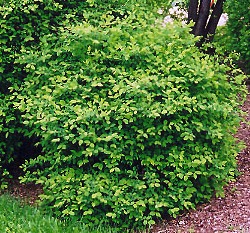Edible of the Month: Honeyberry

Honeyberries produce elongated blue fruits that are tasty and high in vitamins and minerals.

Some honeyberry varieties produce fruits that look and taste like blueberries. However, they mature two weeks before strawberries.
Sometimes it's good to stretch your horticultural imagination. While there are plenty of great berry crops to grow in gardens, there also are some unusual ones that might be worthy of your attention.
Amelanchier or service berries are a good example of a native shrub that is commonly grown as an ornamental, but has varieties (called saskatoons) that produce excellent fruit as well.
The shrub that I'm excited about right now is the honeyberry. Honeyberry (Lonicera caerulea) is in the honeysuckle family. Like many ornamental honeysuckles, honeyberry bushes are widely adapted, have few pests, and are easy to grow. But unlike most honeysuckles, honeyberries produce small,
elongated, blue fruits that taste like blueberries.
Honeyberries are native to eastern Russia and hardy to -40F (zone 3), but can be grown as far south as USDA hardiness zone 8. They've been used as a food crop for hundreds of years in Asia and Eastern Europe, but are only recently catching on in North America. The shrubs grow 5- to 7-feet tall and wide. They flower early in the season and produce fruits before strawberries ripen. So in many places, they will
be the first fruits you harvest. The fruit quality varies depending on the variety. Most often it is described as blueberry-like, although some people will describe the taste as closer to that of raspberries or saskatoons. They are best eaten fresh out of hand or used to flavor yogurts, ice cream, breads, or made into jams and jellies. The fruits are also high in antioxidants, vitamins, and minerals.
Planning
Honeyberry shrubs grow best in part sun in the south and full sun in the northern locations. You'll need at least two different varieties for cross pollination. Because of the plant's ultimate size,
honeyberries are well adapted to being used as a hedge or a foundation plant in an edible landscape. The plants are attractive even when not flowering and fruiting, with grey-green foliage and yellow fall leaf color. Some honeysuckles can be invasive and the jury is still out on whether honeyberry falls into this category, so keep an eye on it.
For an unusual berry crop, there are already a number of named varieties. Here is a selection of what's available to date.
'Berry Blue' – A large variety that grows to 8 feet tall and produces large berries as well.
'Blue Belle' – A 4- to 5-foot tall and wide variety that produces roundish, deep blue berries.
'Blue Bird' – An early blooming, 6 foot tall and wide shrub that has elongated dark blue fruits.
'Blue Forest' – This dwarf variety only grows 3 feet tall and wide and has a more spreading form than other varieties.
'Blue Velvet' – This variety features attractive grey-green foliage and very large, medium blue fruits on a 4 foot tall and wide bush.
'Kamchatka' – A variety from Siberia, it's a late bloomer, making it a good choice in areas with late spring frosts. It's produces dark blue fruits on semi-upright, 3- to 4- foot tall shrubs.
Preparation
Honeyberries grow best in moist, well-drained soil. The ideal pH is 6.5, but they are adapted to a pH range of 5 to 8. Unlike many other berries, they produce well in a partly shaded location and on wet, clay soils, although they do best on a well-drained soil.
Planting

Honeyberry shrubs can grow 3 to 7 feet tall and wide depending on the variety. It makes a carefree, edible landscape plant in a hedge or used as a
foundation plant.
Space plants 5- to 7- feet apart in rows. Mix and match varieties for proper pollination. Honeyberry shrubs like a humus-rich soil. Dig a one foot diameter hole and amend the soil with peat moss and compost.
Care
Like blueberries, honeyberry shrubs have shallow root systems, so benefit from a good layer of organic mulch. Spread bark, sawdust, or leaf mulch 2- to 4-inches deep around the shrubs. Replenish annually.
The mulch will keep the soil evenly moist, helping the berries reach maximum size and allowing for better nutrient uptake by the roots as the mulch decomposes. Fertilize your bushes based on a soil test. If you're growing on very poor quality soil, or if you notice nutrient deficiency symptoms on the leaves and small fruits, consider adding a complete organic fertilizer in spring.
Honeyberries have few insect and disease problems, but you may have to net bushes to discourage birds from eating the ripe fruits. Keep plants well watered and weeded, especially when young. Little pruning is needed on bushes younger than five years old other than removing dead, diseased, or broken branches. After that, periodically remove older limbs and spindly shoots to make room for thicker, young limbs to grow. Ideally you should have four to six older limbs and a few younger
shoots per shrub. Prune in late winter. Since honeyberries bloom so early in spring, the shrubs may need protection from late spring frosts.
Harvest
Honeyberries start producing fruit the first year after transplanting, but may take a number of years to reach full production. They flower early, and most varieties produce fruit two weeks before
strawberries. Let fruits turn blue throughout for the best flavor. Often fruit skins will turn blue while the flesh is still green, resulting in a tart flavored berry. They fruit for two to three weeks in spring and will produce fruit for up to 30 years.
Views: 5
© 2025 Created by Aggie.
Powered by
![]()